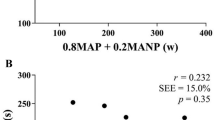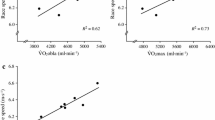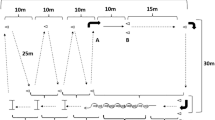Abstract
The aim of the present study was to analyze rest energy expenditure (REE) and energy expenditure (EE) during submaximal exercise in athletes. We performed a retrospective analysis of data from 2014 to 2020 among cross-country skiers in the preparatory phase. Depending on the potential performance, athletes (n = 136) were divided into two groups: I – test completed to the anaerobic threshold (AnT), II – test completed until exhaustion. The present study included the data only up to AnT for a correct comparison of the results. REE was 2058.5 ± 220.5 kcal/day in group I and 2023.1 ± 216.4 kcal/day in group II (p = 0.481) with a significant difference in the respiratory coefficient (p < 0.000). In the REE structure, the contribution of fats and carbohydrates (CHOs) was 69 and 31% in group I, 48 (p = 0.021) and 52% (p < 0.000) in group II. Correlations between VO2rest and REE, as well as the rate of fats and CHOs oxidation at rest were revealed. In groups I and II the VO2AnT (p < 0.000) and relative values of VO2max (p < 0.05) were significantly different. EE up to AnT was 135.9 ± 31.2 and 134.0 ± 23.4 kcal (p = 0.399) for I and II groups. The amount of fats and carbohydrates spent during the test before the AnT was 6.3 ± 2.0 and 20.7 ± 4.4 g in group I and 7.1 ± 1.7 (p < 0.05) and 15.8 ± 5.9 (p < 0.000) g in group II. The present study showed that the 1 : 1 balance of fats and CHOs in the REE structure is a more informative performance marker than quantitative assessment of EE. VO2AnT reduced by 20% relative to VO2max may indicate the functional economization and the body’s ability to perform exercise over a long period of time, including anaerobic exercise. Endurance athletes demonstrated the economy of CHOs against active use of fats during submaximal exercise. Complex estimation of performance indicators and EE (including contribution of fats and CHOs) should be considered when studying the performance of athletes.



Similar content being viewed by others
REFERENCES
Levine, J.A., Measurement of energy expenditure, Public Health Nutr., 2005, vol. 8, no. 7A, p. 1123.
Westerterp, K.R., Physical activity and physical activity induced energy expenditure in humans: Measurement, determinants, and effects, Front. Physiol., 2013, vol. 4, p. 90.
Redondo, R.B., Resting energy expenditure; assessment methods and applications, Nutr. Hosp., 2015, vol. 31, suppl. 3, p. 245.
MacLean, P.S., Bergouignan, A., Cornier, M.-A., and Jackman, M.R., Biology’s response to dieting: The impetus for weight regain, Am. J. Physiol.: Regul. Integr. Comp. Physiol., 2011, vol. 301, no. 3, p. R581.
Esteves de Oliveira, F.C., de Mello Cruz, A.C., Gonçalves, O.C., et al., Gasto energético de adultos brasileños saludables: Una comparación de métodos, Nutr. Hosp., 2008, vol. 23, no. 6, p. 554.
MacKenzie-Shalders, K., Kelly, J.T., Daniel, S., et al., The effect of exercise interventions on resting metabolic rate: A systematic review and meta-analysis, J. Sports Sci., 2020, vol. 38, no. 14, p. 1635.
Jagim, A.R., Camic, C.L., Kisiolek, J., et al., Accuracy of resting metabolic rate prediction equations in athletes, J. Strength Cond. Res., 2018, vol. 32, no. 7, p. 1875.
Purcell, S.A., Johnson-Stoklossa, C., Braga Tibaes, J.R., et al., Accuracy and reliability of a portable indirect calorimeter compared to whole-body indirect calorimetry for measuring resting energy expenditure, Clin. Nutr. ESPEN, 2020, vol. 39, p. 67.
Rømer, T., Thunestvedt Hansen, M., Frandsen, J., et al., The relationship between peak fat oxidation and prolonged double-poling endurance exercise performance, Scand. J. Med. Sci. Sports, 2020, vol. 30, no. 11, p. 2044.
Lyudinina, A.Y., Bushmanova, E.A., Varlamova, N.G., and Bojko, E.R., Dietary and plasma blood α-linolenic acid as modulators of fat oxidation and predictors of aerobic performance, J. Int. Soc. Sports Nutr., 2020, vol. 17, no. 1, p. 57.
Marra, M., Di Vincenzo, O., Cioffi, I., et al., Resting energy expenditure in elite athletes: development of new predictive equations based on anthropometric variables and bioelectrical impedance analysis derived phase angle, J. Int. Soc. Sports Nutr., 2021, vol. 18, no. 1, p. 68.
Watson, A.D., Zabriskie, H.A., Witherbee, K.E., et al., Determining a resting metabolic rate prediction equation for collegiate female athletes, J. Strength Cond. Res., 2019, vol. 33, no. 9, p. 2426.
Matveev, L.P., Problema periodizatsii sportivnoi trenirovki (The Problem of Periodization Training in Sports), Moscow: Fizkul’tura i Sport, 2nd ed., 1965.
Bushmanova, E.A., Loginova, T.P., and Lyudinina, A.Yu., The thermic effect of low-calorie carbohydrate intake on resting energy expenditure, Zh. Med.-Biol. Issled., 2023, vol. 11, no. 2, p. 153.
Fiziologo-biokhimicheskie mekhanizmy obespecheniya sportivnoi deyatel’nosti zimnikh tsiklicheskikh vidov sporta (Physiological and Biochemical Mechanisms Facilitating Sporting Activities of Winter Cyclic Sports), Bojko, E.R., Ed., Syktyvkar: Komi Respublikanskaya Tipografiya, 2019.
McGilvery, R. and Goldstein, G., Biochemistry: A Functional Approach, Philadelphia, PA: Saunders, 1983.
Burke, L.M. and Hawley, J.A., Effects of short-term fat adaptation on metabolism and performance of prolonged exercise, Med. Sci. Sports Exercise, 2002, vol. 34, no. 9, p. 1492.
Maunder, E., Plews, D.J., and Kilding, A.E., Contextualising maximal fat oxidation during exercise: determinants and normative values, Front. Physiol., 2018, vol. 9, p. 599.
Melzer, K., Carbohydrate and fat utilization during rest and physical activity, Clin. Nutr. ESPEN, 2011, vol. 6, p. e45. https://doi.org/10.1016/j.eclnm.2011.01.005
Lyudinina, A.Yu., Bushmanova, E.A., Eseva, T.V., and Bojko, E.R., Accordance of energy intake to energy expenditure in skiers across the preparation phase, Vopr. Pitan., 2022, vol. 91, no. 1, p. 109.
Glancy, B., Hartnell, L.M., Malide, D., et al., Mitochondrial reticulum for cellular energy distribution in muscle, Nature, 2015, vol. 523, no. 7562, p. 617.
Jacobs, R.A. and Lundby, C., Mitochondria express enhanced quality as well as quantity in association with aerobic fitness across recreationally active individuals up to elite athletes, J. Appl. Physiol., 2013, vol. 114, no. 3, p. 344.
Da Boit, M., Hunter, A.M., and Gray, S.R., Fit with good fat? The role of n-3 polyunsaturated fatty acids on exercise performance, Metabolism, 2016, vol. 66, p. 214.
Andersson Hall, U., Edin, F., Pedersen, A., and Madsen, K., Whole-body fat oxidation increases more by prior exercise than overnight fasting in elite endurance athletes, Appl. Physiol. Nutr. Metab., 2016, vol. 41, no. 4, p. 430.
Achten, J. and Jeukendrup, A.E., Maximal fat oxidation during exercise in trained men, Int. J. Sports Med., 2003, vol. 24, no. 8, p. 603.
San-Millán, I. and Brooks, G.A., Assessment of metabolic flexibility by means of measuring blood lactate, fat, and carbohydrate oxidation responses to exercise in professional endurance athletes and less-fit individuals, Sports Med., 2018, vol. 48, no. 2, p. 467.
Dong, S., Qian, L., Cheng, Z., et al., Lactate and myocardiac energy metabolism, Front. Physiol., 2021, vol. 12, p. 715081.
Varlamova, N.G., Loginova, T.P., Garnov, I.O., et al., Heart rate, oxygen consumption and arterial pressure in skiers of different skill levels in the test to exhaustion, Chel. Sport. Med., 2021, vol. 21, no. 1, p. 53.
Funding
The work was carried out at the expense of subsidies for the implementation of state assignment no. GR1021051201877-3-3.1.8 (2022–2026).
Author information
Authors and Affiliations
Corresponding authors
Ethics declarations
Ethics approval. All studies were carried out in accordance with the principles of biomedical ethics formulated in the Declaration of Helsinki of 1964 and its subsequent updates and were approved by the local ethics committee of the Institute of Physiology, Federal Research Center, Komi Scientific Center, Ural Branch, Russian Academy of Sciences on December 28, 2022 (Syktyvkar).
Informed consent. Each participant in the study provided a voluntary written informed consent signed by him after explaining to him the potential risks and benefits, as well as the nature of the upcoming study.
Conflict of interest. The authors declare the absence of obvious and potential conflicts of interest related to the publication of this article.
AUTHOR CONTRIBUTION
E.A. Bushmanova: a significant contribution to the concept of work, data collection, processing and analysis, and writing the text of the manuscript. A.Yu. Lyudinina: development and coordination of the study, critical revision of the text of the manuscript, and approval of the final version of the article for publication.
Additional information
Translated by A. Deryabina
Rights and permissions
About this article
Cite this article
Bushmanova, E.A., Lyudinina, A.Y. Rest Energy Expenditure and Energy Expenditure During Submaximal Exercise: New Approach to Assessment of Performance in Skiers. Hum Physiol 49, 538–544 (2023). https://doi.org/10.1134/S0362119723600169
Received:
Revised:
Accepted:
Published:
Issue Date:
DOI: https://doi.org/10.1134/S0362119723600169




